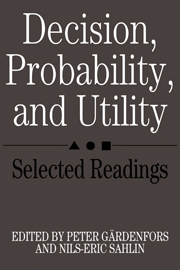Book contents
- Frontmatter
- Contents
- List of contributors
- Preface
- 1 Introduction: Bayesian decision theory – foundations and problems
- Part I Foundations of Bayesian decision theory
- Part II Conceptualization of probability and utility
- Part III Questionable rules of rationality
- Part IV Unreliable probabilities
- Part V Causal decision theory
- References
- Name index
- Subject index
1 - Introduction: Bayesian decision theory – foundations and problems
Published online by Cambridge University Press: 05 June 2012
- Frontmatter
- Contents
- List of contributors
- Preface
- 1 Introduction: Bayesian decision theory – foundations and problems
- Part I Foundations of Bayesian decision theory
- Part II Conceptualization of probability and utility
- Part III Questionable rules of rationality
- Part IV Unreliable probabilities
- Part V Causal decision theory
- References
- Name index
- Subject index
Summary
Traditional Bayesian decision theory
We are forced to make decisions numerous times every day. Some of these decisions are made consciously, sometimes well deliberated; some of them are simply the result of habit, be it good or bad. In a sense, our decisions derive from our wants and we make them because we believe that our actions will influence the world in such a direction that our wants are more likely to be fulfilled. Because the outcomes of our decisions have an impact on our everyday lives, we want to make good decisions. This should be the case whether we buy tomatoes in the supermarket, make a major investment in the stock market, or choose a lifelong partner. A key question is, how do we know when our decisions are rational? Psychologists keep telling us that, in many situations, we are not particularly good at making rational decisions. This does not mean, however, that we cannot formulate a rational theory of how to make good decisions.
This volume contains a number of articles on rational decision making, some of which explicitly formulate recommendations on how to make good decisions, and some of which criticize these recommendations and their theoretical foundations. However, a common core of the articles is that there are two main types of factors determining our decisions. One is our wants or desires. These determine the values or utilities of the possible outcomes of our decisions.
- Type
- Chapter
- Information
- Decision, Probability and UtilitySelected Readings, pp. 1 - 16Publisher: Cambridge University PressPrint publication year: 1988
- 1
- Cited by



